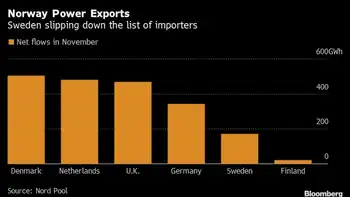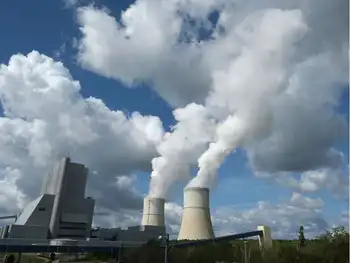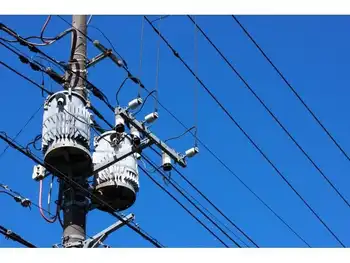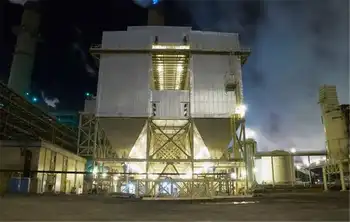Is small the future of nuclear generation?
By Toronto Star
Arc Flash Training CSA Z462 - Electrical Safety Essentials
Our customized live online or in‑person group training can be delivered to your staff at your location.

- Live Online
- 6 hours Instructor-led
- Group Training Available
It's efficient because power is generated where it's used. It's flexible because projects can be built quickly when needed. It saves money in the long run because there's less need for expensive transmission lines that carry the power elsewhere. And if one generator fails, its relatively small size means it doesn't threaten the stability of the entire system.
This, of course, is the antithesis of centralized power generation that relies on a dozens or so large nuclear and fossil-fuel plants. Proponents of distributed generation cite the massive size and cost of nuclear power plants as one reason, beyond safety and waste-management concerns, and the technology is unsustainable and far too risky.
Not so, argues one start-up firm from Santa Fe, N.M., which has high hopes of expanding the definition of distributed generation to include nuclear power.
Hyperion Power Generation Inc. has developed a garden shed-sized nuclear reactor that can produce enough heat to generate 25 megawatts of electricity for up to 10 years.
That's enough energy to power 20,000 homes, but still tiny by current nuclear standards. An Advanced Candu Reactor, for example, is 48 times larger and a next-generation Areva reactor is 64 times larger.
Hyperion, which calls its reactor as a "nuclear battery," licensed the technology from the Los Alamos National Laboratory in New Mexico. It plans to sell the reactor for about $30 million (U.S.) and says there's potential to sell 4,000 of them around the world by 2025.
The company already claims more than $2 billion worth of orders in the pipeline and more than 100 "firm" orders.
One of its first target markets: Alberta's oil sands. Hyperion chief executive John Deal is the only nuclear executive that will sit on the 2009 advisory board of the "Oil Sands and Heavy Oil Technologies" conference that will be held in Calgary in July.
The idea is that oil-sands developers, which rely heavily on electricity and steam to mine and upgrade bitumen, could purchase and operate their own Hyperion nuclear reactors as a way to virtually eliminate their controversial dependence on natural gas – that is, the use of a relatively "clean" fossil fuel as a way to extract and process one of the dirtiest fossil fuels.
By using nuclear instead of natural gas, oil-sands developers aim to dramatically lower their greenhouse-gas emissions. Atomic Energy of Canada and Areva are also marketing their reactors to Alberta, but Hyperion's reactor, because of its small size, offers a tiny bite that's much easier for industry to chew and ultimately swallow.
"It was really created for the Alberta tar sands... we have strong interest there," says Deborah Blackwell, vice-president of licensing and public affairs at Hyperion.
"It's changing the whole way of thinking about nuclear power and it goes back to this concept of distributed generation."
I can imagine some environmentalists reading this article just cringing at the very thought. Suddenly, one of their big arguments for opposing nuclear power loses its steam. At the same time, the concept could win over a few environmental allies given urgent the need to curb greenhouse-gas emissions.
"It's a very interesting idea and it has a lot of supporters," says Stephen Aplin, head of energy consulting with Ottawa-based HDP Group Inc.
"And it's not just Hyperion. Other U.S. vendors of small reactors include NuScale, Adams Atomic Engines and any U.S. firm that develops the Liftr, or liquid fluoride thorium reactor."
So how does Hyperion's atomic battery, which weighs about 15 tonnes and is about 2 metres tall, actually work?
It's based on the design of a TRIGA reactor, which stands for "Training, Research, Isotopes, General Atomics." These are small reactors first built about 40 years ago and used by students of nuclear science. About 23 are operational today around the world.
TRIGA reactors use low-enriched uranium hydride as a fuel, which can't be used to make a bomb, and they're designed to make a meltdown virtually impossible. In other words, no containment building is required.
"The secret of the fuel is that it cools itself off," says Blackwell.
When uranium hydride gets too hot, above 550 degrees Celsius, it will shed hydrogen atoms. The hydrogen flows out of the core and is stored in special storage trays within the reactor. As the fuel loses hydrogen atoms it begins to naturally cool. As it cools, it will retrieve the hydrogen atoms from the trays.
The whole process is self-limiting. A runaway chain reaction isn't possible – at least that's what the company claims.
Blackwell compares the reactor to lungs that inhale and exhale hydrogen in a natural balance that keeps the reactor at a fairly constant temperature.
This built-in safety feature makes it possible to plop one of these reactors in a remote area, like a military base, island community, or oil-sands development, without the need for massive concrete containment buildings, cooling towers or transmission infrastructure. Another bonus: no water is needed for cooling.
Still, even without the claimed meltdown risks there are the obvious concerns about tampering, attacks from terrorists and what to do with the nuclear waste. It's one thing to keep a watchful eye on a few hundreds large nuclear plants around the world, but keeping thousands of mininukes out of the wrong hands could prove challenging.
Not really, argues Hyperion. It plans to mass produce the reactors in a secure factory, seal them on site and transport them directly to customers on a flatbed truck equipped with special security. Once on a customer site, the company will bury the reactor three metres underground before it is switched on. After that, minimal human intervention is required.
"All of our units will have remote sensors on them and they're all monitored around the clock. And there's on-site monitoring as well. We will know what's going on with every one of those units at all times," Blackwell maintains.
The factory-sealed reactor would stay safely underground until the fuel is used up in five to 10 years, depending on the electricity load. In this sense, it does operate much like a battery. Hyperion will then dig up the expired unit and transport it back to its central facility for proper disposal or, if possible, refueling, resealing and resale.
TES Group SA, an energy investment company in Eastern Europe, has already signed a "letter of intent" to purchase six reactors from Hyperion and possibly 50 more in a follow-on order. The group wants to deploy the units in Romania and the Czech Republic.
Blackwell says the aim is to start commercial production of the reactors by 2013. Hyperion is in talks with the U.S. Nuclear Regulatory Commission about obtaining a manufacturing license.
"It's the first time anybody has mass manufactured a nuclear power plant, the same one over and over again,'' Blackwell says. ``We are forging through uncharted territory here. It's part of the reason this could take a while."
But is charting through this territory a good idea?
The fact is the units would still produce nuclear-fuel waste – a football-sized amount for each reactor – and while it would be collected by Hyperion and managed at a central location, a large part of the population believes it immoral to create and leave behind highly toxic waste for future generations.
Can a company like Hyperion be trusted to transport, collect and manage this waste from potentially thousands of sites? And how, some might ask, is it environmentally responsible to turbo boost oil-sands development with nuclear power?
These are questions deserving of wider public debate and ones that nuclear regulators in Canada and around the world will have to answer. If, however, we're comparing Hyperion's distributed-generation approach to the conventional "go big" nuclear approach, the benefits are clear.
Efficient. Flexible. Safer. Transportable. Scalable. Swappable. In the world of nuclear energy, small could end up becoming the new big.
If only it wasn't nuclear.











